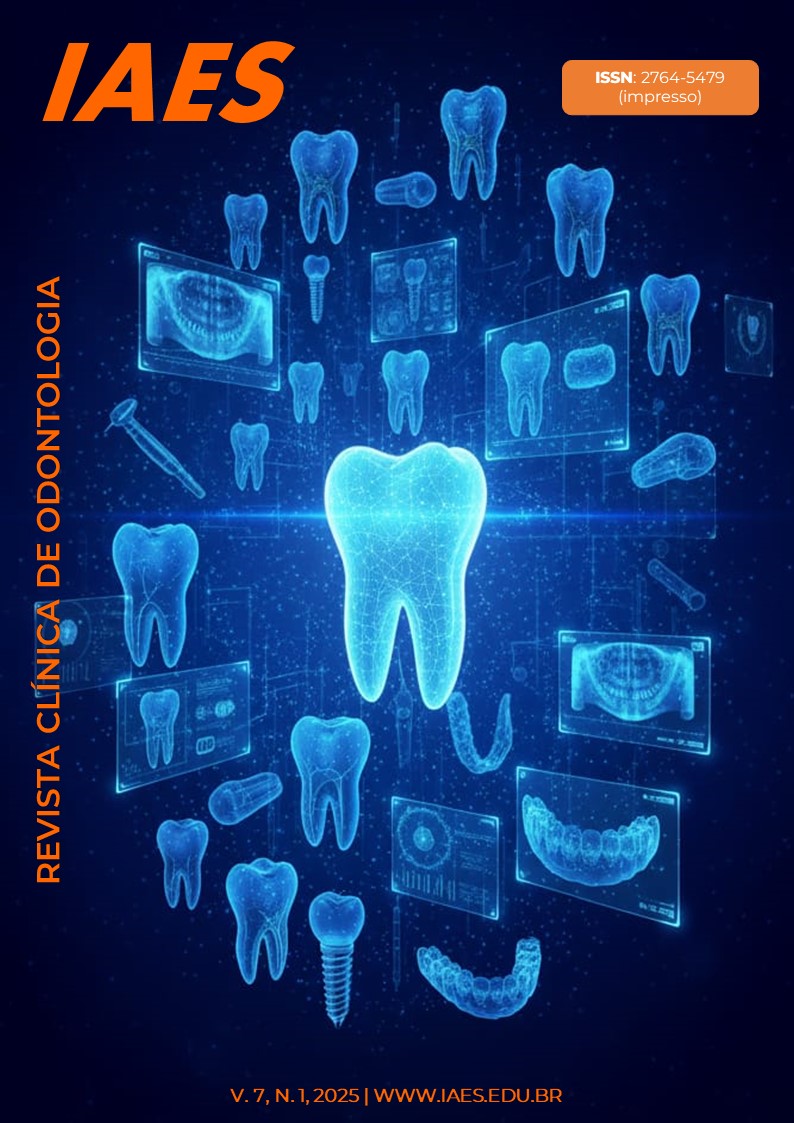Endodontic retreatment with reciprocating instrumentation using a single Reciproc Blue file (VDW): case report
DOI:
https://doi.org/10.70614/r1x1ye64Keywords:
Endodontics, Dental caries, ToothacheAbstract
The success of endodontic treatment is related to the correct selection of the case, the preparation and filling techniques used, the skill of the operator, in addition to being associated with the technical difficulties that the case offers. However, many cases result in failures related to microbial, morphological, and technical factors such as partial filling of the root canal without reaching the apical limit. Endodontic retreatment consists of carrying out a new treatment, it may be because the previous one failed or, simply, because you want to carry out a more correct and appropriate treatment. In view of the above, the present report aims to report the endodontic retreatment of element 21 with Reciproc Blue® reciprocating instrumentation as a therapeutic option for endodontic failure. Patient A.L.M., 27 years old, female, Caucasian, attended the Endodontics Clinic at Faculdade do Amazonas – IAES reporting intense pain in her front tooth as her main complaint. She was diagnosed with unsatisfactory endodontic filling based on clinical and radiographic examinations. For the treatment plan, the Reciproc Blue file system was determined for the unfilling and treatment of the root canal, so that it is possible to reach the apical foramen and end with a new satisfactory and safe filling. Given the case carried out, it seems reasonable to conclude that the Reciproc Blue® system presents excellent clinical performance, guaranteeing cleanliness and safe formatting as the instrument is resistant to fatigue and torsion. As it is a single-file system, it also adds less operative time. Endodontic reintervention is a necessary and effective therapy when performed technically and precisely.
Downloads
References
1. Zappe BB. Retratamento endodôntico: relato de caso clínico [especialização]. Universidade Federal do Rio Grande do Sul; 2018.
2. Lopes HP, Siqueira Jr. JF. Endodontia: biologia e técnica. 4th ed. Rio de Janeiro: Guanabara Koogan; 2012.
3. Gomes BPFA et al. Atividade antimicrobiana in vitro de diversas concentrações de hipoclorito de sódio e gluconato de clorexidina na eliminação de Enterecoccus Faecalis. Int Endod J. 2001;34(6):424–8.
4. Limongi O, Troian C, Viegas AP, Baratto Filho F, Irala LE, Maia SMAl. Desobsturação do canal radicular: o desempenho dos solventes óleo de laranja e eucaliptol. RGO (Porto Alegre). 2005;341–5.
5. Poveda LM. Avaliação da resistência à fadiga cíclica flexural dos instrumentos Reciproc Blue e WaveOne Gold [dissertação]. Universidade de São Paulo; 2017.
6. Plotino G, Grande NM, Testarelli L, Gambarini G. Cyclic fatigue of Reciproc and WaveOne reciprocating instruments. Int Endod J. 2012;45(7):614–8.
7. Ritt AS, Buco J, Wagner MH, Rosa RA, Vier-Pelisser F V, Só MVR. Avaliação da eficácia da instrumentação manual x automatizada durante o retratamento endodôntico em canais radiculares obturados com guta-percha e cimento à base de hidróxido de cálcio. RFO UFP. 2012;17(1):55–9.
8. Reis PSC. Protocolo clínico dos sistemas de limas mecanizadas reciproc blue e trunatomy [especialização]. Universidade Federal de Minas Gerais; 2022.
9. Soares JI GF. Endodontia: técnicas e fundametos. 2nd ed. Porto Alegre: Artmed; 2011.
10. Wilcox LR, Krell K V., Madison S, Rittman B. Endodontic retreatment: evaluation of gutta-percha and sealer removal and canal reinstrumentation. J Endod. 1987;13(9):453–7.
11. Morais CAH, Duarte MAH, Moraes IG, Bernardineli N. Avaliacao do poder solvente de guta-percha, de quatro substâncias quimicas (1995). Rev da Fac Odontol Bauru. 1995;3(1–4):1–3.
12. França MIAF, Pinto DC de S, Soldá MM, Cruz ATG, de Aragão EM, Heck AR. Avaliação in vitro da eficácia de diferentes solventes sobre os cones de guta-percha F3. Full Dent Sci. 2022;13(52):118–21.
13. Justo AM. Estudo in vitro da efetividade de diferentes protocolos de irrigação final para a remoção de detritos e lama dentinária do terço apical de canais radiculares [especialização]. Universidade Federal do Rio Grande do Sul.
14. Bartols A, Robra BP, Walther W. The ability of Reciproc instruments to reach full working length without glide path preparation: A clinical retrospective study. PeerJ. 2017;5(7):e3583.
15. Peters OA, de Azevedo Bahia MG, Pereira ESJ. Contemporary root canal preparation: innovations in biomechanics. Dent Clin North Am. 2017;61(1):37–58.
16. Almeida LLBL. Análise comparativa de dois sistemas de instrumentação mecanizada de canais radiculares: Reciproc Blue® e ProTaper Next® [dissertação]. Universidade Fernando Pessoa; 2019.
17. Farias ALV. Eficácia das limas reciprocantes Reciproc Blue e Prodesign R na remoção de material obturador: uma revisão integrativa da literatura [dissertação]. CESPU; 2020.
Downloads
Published
Issue
Section
License
Copyright (c) 2025 Revista Clínica de Odontologia

This work is licensed under a Creative Commons Attribution 4.0 International License.






